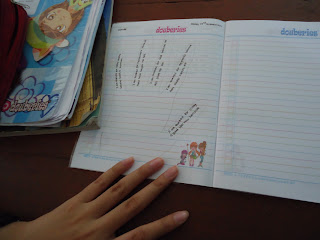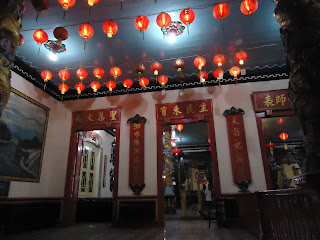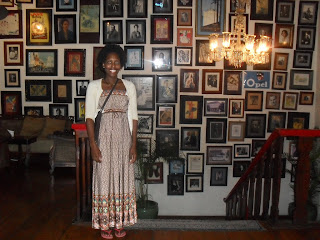[Happy November! I cast my vote via absentee ballot a month ago and am excited to see how the election plays out back home. The rest of the world is watching. So, cheers to a smooth election!]
Last weekend, Amanda (another Fulbrighter) and I decided to go to Jakarta for the Eid al-Adha holiday weekend. We were looking to get some rest, relax, tour the city, and have some fun. We got all of that and more, and we were incredibly exhausted when it was time to return to our sites in Borneo (she lives in Tarakan, East Borneo).
Friday, 26 October, was a jam packed day. As soon as we landed in Jakarta, we dropped off our belongings at Michael's (an ELF working in Jakarta and our awesome host for the weekend) house in Rawamangun, east Jakarta. We hopped into a
banjai (a type of taxi) and ventured into the town.
Our first stop was the
Monumen Nasional (National Monument) also known as
Monas, at Merdeka Square in central Jakarta. The white-washed structure towers over Merdeka Square and has a golden tip. The first president of Indonesia started its construction in 1961, but it was not finished until 1975 under Indonesia's second president, Suharto. People stood in long lines at the base to get a view of the city at the top, and unfortunately, Amanda and I did not get to climb the tower. Instead, we walked around the square which is laced with tall palm trees and enjoyed the peaceful scene of people walking and playing all across the square. If you plan to walk anywhere in Jakarta, bring a cap, a parasol, and some sunscreen; the heat is intense. Amanda and I did not have any of those and we were soaked with sweat.
Photo op in a banjai!
Monumen Nasional (Monas).
Merdeka Square.
Statue at the southern entrance to Monas.
After Monas, we took another banjai
to Cikini, in southeast Jakarta, for lunch. Amanda dined on sushi and noodles, and I had rice with curry chicken at
Kikugawa, a Japanese restaurant. We wanted to get some shopping done while we were there so we went to FX Mall in the Senayan district. I purchased a pair of badly needed flip flops since I could not find my size in Pontianak (the largest size is around an 8 for women). The mall has a 72m transparent cylindrical slide that shoots a person down six stories in about 12 seconds. So, of course, we tried it. I will be honest, I was actually scared to go on it. I only went because they offered Amanda two more chances to ride it, and I thought I should be adventurous and decided to go for it. It was quite the adrenaline rush. Everyone could hear me screaming as I slid down the slide, and Amanda would not stop imitating my screams and laughing at me. It was definitely worth the ride, though.
Amanda, after being shot down the slide.
In an effort to take full advantage of the remaining sunlight, we took a taxi to Ancol Marina in Ancol, north Jakarta. Our main plan was to swim with some dolphins, but we missed the showtimes. We decided to go on a cable car ride above the entire park instead. That was my first time in a suspended cable car. We had a great view of the sun setting over the city and people playing and swimming at the hotel pool or on the artificial beaches below. Soon after sunset, we ended our day with dinner at a mall with Mike, his wife, and a few other ELF's.
View from the cable car at Ancol Marina.
The sun setting over Ancol.
The next day, we woke up early and went to Museum Nasional. We saw beautiful jewelry, traditional clothing, and sculptures from the ancient kingdoms of the main islands of Indonesia. The history of the country was overwhelming; there is simply so much to learn.
We were not able to see both buildings in their entirety because we had a lunch date at noon.
The entrance to Museum Nasional.
Outside display on the ground level.
A sculpture from Bali.
Jewelry from my island, Kalimantan (Borneo).
We went to Kemang, in south Jakarta, to meet with Mia, a Fulbrighter from a couple of years ago, who works at a school in Jakarta. Kemang has a cool and hip vibe. Amanda and I got to know Mia better over pizza and pasta at
Pasta Basta. The pizza, which was the closest thing to NYC pizza I have had since I arrived here, was delicious. Then, we went to
Amigos, a Mexican restaurant, for dessert. We connected more over ice cream and went grocery shopping at a market across the parking lot. Amanda and I thoroughly enjoyed meeting and getting to know Mia. Darkness started to set in and after hanging out at her apartment, we headed back to the busway into Rawamangun. We needed to get ready for Saturday night's festivities.
Dessert at Amigos.
As Mia, Amanda, and I walked around Kemang, we
saw this man with some slaughtered cattle to celebrate
the Eid al-Adha holiday. The Muslim holiday celebrates
Abraham's (the prophet) willingness to sacrifice his child
to God and signifies the end of the annual hajji to Mecca.
I had been itching to dance some salsa here and found out about salsa dancing at the Ritz-Carlton Jakarta. Yes, there is salsa in Indonesia! It was a memorable experience; the dancers were very talented and I even got to dance bachata and the cha cha cha. After salsa, Amanda and I met up with some other friends at
Domain, a club at Senayan City Mall, for a birthday celebration. We danced into the early morning. On our way home, the craziest thing happened - our taxi was mobbed by
waria (ladyboys). One walked right in front of the taxi and while all eyes were on him, another came to my side of the car and tried to open the door. A friend who has lived in Indonesia for a long time told me that the waria are very aggressive at trying to get clients. Amanda and I had seen one waria earlier that night and we had to do a double take because we had never seen one before. He was beautiful. It was kind of like seeing a mythical creature. You know, like a unicorn. However, at that moment, the yellow street lights casted on their faces, their heavy make-up, and their oversized breasts and behinds made them look scary. The driver honked and they moved out of the way.
Ready for a night of salsa at the Ritz-Carlton Jakarta.
On our last full day in Jakarta, after getting some necessary rest, we went to the old city of Kota, in north Jakarta. In Kota, one can see the influence of the Dutch in the city's architecture. We saw a handful of beautiful white buildings as we wandered onto Taman Fatahillah Square. It is surrounded by colonial buildings, and vendors and people covered the cobblestone streets. Some vendors played
dangdut (hip Indonesian music with an attractive and mesmerizing beat), others sold coconuts, mangoes, cake, and other tasty foods. We snacked on mangoes and
kue kamir (a slightly sweet and doughy cake) as we absorbed the sights and sounds of the lively square. We had dinner at the seemingly high-end
Cafe Batavia (Jakarta was named Batavia during Dutch occupation). Pictures cover all of the walls, even the ones in the bathroom stalls, and the place makes you feel like you are dining on the
Titanic. I had marinara pasta with squid and shrimp, while Amanda had a fresh Greek salad (something she had been craving for a while). We followed our meals with a cold tall glass of iced tea. Before heading home, we made a quick stop in the heavily Chinese-populated town of Glodok. There was not much to see because it was getting late and many shops were closing. We did get to see some vendors selling fruits and vegetables on narrow streets decorated with round red lanterns that grace Chinese communities primarily during the new year celebration.
Walking along the street after exiting the bus station in Kota.
Taman Fatahillah Square.
The old town hall building.
Inside Cafe Batavia.
Monday was our travel day. We had a mouth-watering breakfast at a nearby warung before Amanda flew out. I squeezed in an afternoon nap before my evening departure.
Waiting for breakfast at a warung.
Jakarta, also known as the Big Durian, is a force to be reckoned with. The traffic jams I had always heard about are no joke. I learned the Indonesian word for traffic jam while I was there. It is
macet. By the second day, we were riding the busway to save money (the taxi rides were adding up!) and beat the traffic. The busway has its own lane and, for the most part, other motorists obey the lane rules even when they get tuck in gridlock. Amanda and I enjoyed figuring out the city's transportation system and using our improved Indonesian to make our way all over the capital. I left with a better understanding of why some people might not like living there. It is tiring for sure. But the Big Durian is definitely worth another trip.
A gorgeous sculpture near Merdeka Square.
Fountain Roundabout near Merdeka Square.
The president's office. We actually saw his motorcade
(several tanks and police cars) as we walked around the city.
A picture of my favorite roundabout, the
Welcome Roundabout in south Jakarta.
The view from an overpass as we transfer buses.
A view of the serious macet as Amanda and I wait
for the bus on the TransJakarta busway. You can see
one motorist breaking the lane rules to bypass the traffic jam.
currentVote
noRating
noWeight









































































